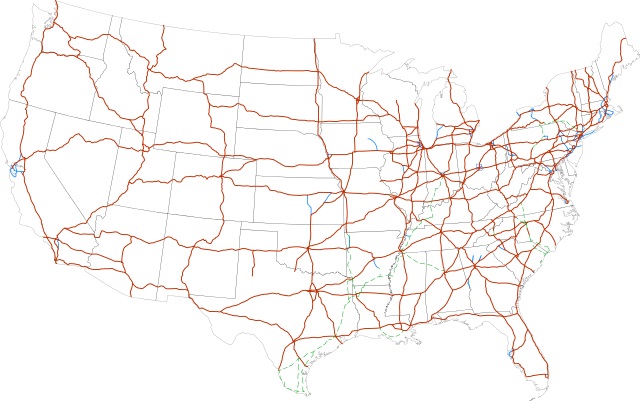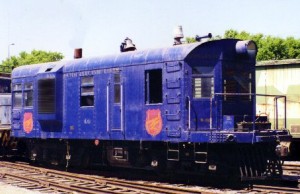June 26, 1885 – Natural Gas Utility established in Pennsylvania –
Peoples Natural Gas Company incorporated — the first Pennsylvania natural gas company chartered by the state to regulate production, transmission, and distribution of natural gas. A similar utility incorporation had taken place a year earlier in New York City when six competing companies combined to form Consolidated Edison.
By 1891, the Pittsburgh-based limited liability company had consolidated pipelines and facilities of Pittsburgh Natural Gas, Lawrence Natural Gas, Conemaugh Gas, and Columbia Natural Gas companies. More than a dozen more companies would be acquired between 1903 and 1961. The utility added Saxonburg Heat and Light in 1979 and Equitable Gas in 2017, expanding natural gas services in West Virginia and Kentucky.
June 28, 1887 – Kansans celebrate First Natural Gas Jubilee
After erecting flambeau arches at the four corners of the town square, citizens of Paola, Kansas, hosted what local leaders described as “the first natural gas celebration ever held in the West.” Excursion trains from Kansas City brought about 2,000 people “to witness the wonders of natural gas,” according to the Miami County Historical Museum, which preserves the region’s petroleum history.

Paola’s giant natural gas field attracted more petroleum exploration to Miami County, including this circa 1920 oil well. Photo courtesy Kansas Historical Society.
The town’s special event included a “grand illumination” of natural gas street lights, where “gas was attached to a yard sprinkler by a rubber hose, and when it was ignited there appeared nests of small blazes which were beautiful and attractive.”
Learn more Sunflower State petroleum history in First Kansas Oil Well.
June 28, 1967 – Hall of Petroleum opens in Smithsonian Museum
The Hall of Petroleum opened at the Smithsonian Institution’s Museum of History and Technology in Washington, D.C. Exhibits included cable-tool and rotary drilling rigs and pumping units, and featured the industry’s onshore and offshore technologies up to 1967. None are on display today.
Visitors to what became the National Museum of American History in 1980 were greeted by a mural painted by Delbert Jackson of Tulsa, Oklahoma. Jackson spent two years creating his 13-foot by 56-foot painting with scenes of oil and natural gas exploration, production, refining, and transportation.

A “Panorama of Petroleum” once greeted visitors to the Smithsonian’s American History Museum in Washington, D.C. The 13-foot by 56-foot mural today is exhibited inside Tulsa International Airport.
Jackson’s “Panorama of Petroleum” featured industry pioneers and served as a visual map to the hall’s oilfield technology exhibits. “If the hall can increase the public’s knowledge of and respect for the technical skill and know-how of those who make this energy available, it will have served its purpose,” noted the exhibit’s catalog.
The “Hall of Petroleum” mural would end up in storage for three decades until finding a home at Tulsa International Airport. Learn more in Smithsonian’s “Hall of Petroleum.“
June 29, 1956 – Interstate Highway System enacted
The Federal-Aid Highway Act of 1956, popularly known as the National Interstate and Defense Highways Act, became law. Passed at the urging of President Dwight D. Eisenhower, the act provided 90 percent federal funding for a “system of interstate and defense highways,” and authorized spending $25 billion through 1969 for construction of about 41,000 miles of interstates.

The U.S. interstate system had a total length of 48,191 miles by 2016. Federal regulations initially banned collecting tolls, but some interstate routes today include toll roads.
“Of all his domestic programs, Eisenhower’s favorite by far was the Interstate System,” noted historian Stephen Ambrose. The thirty-fourth president urged passage of the act for national defense; interstates would be needed for evacuating major cities during a nuclear war.
June 30, 1864 – First Oil Tax funds Civil War
The federal government taxed oil for the first time when it levied a $1 per barrel tax on production from Pennsylvania oilfields.

Seeking ways to pay for the Civil War, Treasury Secretary Salmon Chase, featured prominently on the $1 “greenback,” advocated an oil tax.
Desperate for revenue to fund the Civil War as early as 1862, Treasury Secretary Salmon Chase advocated a $6.30 tax per barrel of oil and $10.50 per barrel on refined products. Angry oil producers rallied against the tax in Oil City, Pennsylvania, and sent delegates to Washington, D.C., where they negotiated a tax of $1 per 42-gallon barrel of oil.
July 1, 1919 – Top Independent Producers join Association
The two-year-old Mid-Continent Oil & Gas Association (today’s U.S. Oil & Gas Association) established its Kansas-Oklahoma Division in Tulsa.

Alf Landon served as Kansas governor and was the 1936 Republican presidential candidate.
Mid-Continent members were a “who’s who” of top independent producers: Frank Phillips of Phillips Petroleum; E.W. Marland, whose company became Conoco; W.G. Skelly, founder of Skelly Oil; H.H. Champlin, founder of Champlin Oil; and Alf Landon, the 1936 Republican presidential candidate. Robert S. Kerr of Kerr-McGee Oil Company was president of the Mid-Continent Division from 1935 through 1941.
July 1, 1922 – Discovery of Smackover Field adds to Arkansas Drilling Boom
First settled by French fur trappers in 1844, Smackover, Arkansas, had a population of just 90 people in 1922 when a wildcat well erupted oil. The well, drilled to 2,066 feet by sawmill owner Sidney Umsted, discovered the 25,000-acre Smackover field. Within six months, 1,000 wells were drilled with a success rate of 92 percent.

Roughnecks photographed following the July 1, 1922, discovery of the Smackover (Richardson) field in Union County. Photo courtesy of the Southwest Arkansas Regional Archives.
Smackover’s population grew to 25,000 and its uncommon name quickly attained national attention. Nearby less than two years earlier, the first commercial oil well in Arkansas, the Busey-Armstrong No. 1, had revealed the giant El Dorado field and launched the career of a young H.L. Hunt.
Learn more in First Arkansas Oil Wells.
July 1, 1938 – The Texas Company discovers Illinois Oilfield
Using a newly introduced technology of seismic exploration, petroleum geologists found hidden anticlines with commercial quantities of oil in Marion County, Illinois. By January 1939 the state’s Salem field was ranked seventh in U.S. daily production. In one year the field produced more than 20 million barrels of oil. Natural gas production in Illinois began as early as 1853 when marsh or “drift gas” was produced from two water wells drilled near Champaign.
Learn more in Illinois Oilfield Museum.
July 2, 1910 – President Taft establishes Naval Petroleum Reserves
As the Navy converted from coal to oil-burning ships, President William Howard Taft established three Naval Petroleum Reserves.
“As a prospective large consumer of oil by reason of the increasing use of fuel oil by the Navy, the federal government is directly concerned both in encouraging rational development and at the same time insuring the longest possible life to the oil supply,” the president declared in a message to Congress.

Commissioned in 1914, the U.S.S. Texas was the last American battleship to be built with coal-fired boilers.
The last U.S. battleship to be built with coal-fired boilers, the U.S.S. Texas, was launched in 1912 and converted to oil-fired boilers in 1926.
Learn more in Petroleum and Sea Power.
July 2, 1913 – Gas-Electric Hybrid marks Beginning of End of Steam Trains
While most U.S. locomotives were still steam-powered, General Electric built the first commercially successful gasoline-powered engine locomotive. Two General Motors 175-horsepower V-8s powered two 600-volt, direct current generators to propel the 57-ton locomotive to a top speed of 51 miles per hour.

The locomotive “Dan Patch,” considered by many to be the first successful internal combustion engine locomotive in the United States.
The Electric Line of Minnesota Company purchased the new gasoline-powered electric hybrid for $34,500, naming it “Dan Patch” in honor of the world’s champion harness horse of the time. By 1930, powerful diesel engines with G.E. generators launched modern train travel with “Streamliners.”
Learn more in Adding Wings to the Iron Horse.
July 2, 1920 – West Columbia oilfield Oilfield discovered in Texas
The Abrams No. 1 well erupted oil in Brazoria County, Texas, revealing the West Columbia oilfield southwest of Houston. Drilled by the Texas Company (the future Texaco), the well initially produced up to 30,000 barrels of oil a day. The well was completed on a 1,650-acre tract owned by railroad official William H. Abrams (1843–1926), who administered millions of acres for the Texas Pacific Land Trust.
Abrams also invested in Mitchell County leases in West Texas, where another 1920 wildcat well discovered the first oil production of the Permian Basin. Three years later, drillers from El Paso would complete the Santa Rita No. 1 well.
_______________________
Recommended Reading: Official Guide to the Smithsonian (2016); Eisenhower: Soldier and President
(1968); Texas Rich: The Hunt Dynasty
(1982); Crazy Good: The True Story of Dan Patch, the Most Famous Horse in America
(2009); Evolution of the American Diesel Locomotive, Railroads Past and Present
(2007); Early Texas Oil: A Photographic History, 1866-1936
(2000). Your Amazon purchase benefits the American Oil & Gas Historical Society. As an Amazon Associate, AOGHS earns a commission from qualifying purchases.
_______________________
The American Oil & Gas Historical Society (AOGHS) preserves U.S. petroleum history. Become an AOGHS annual supporting member to help maintain this energy education website and expand historical research. For more information, contact bawells@aoghs.org. © 2023 Bruce A. Wells. All rights reserved.


